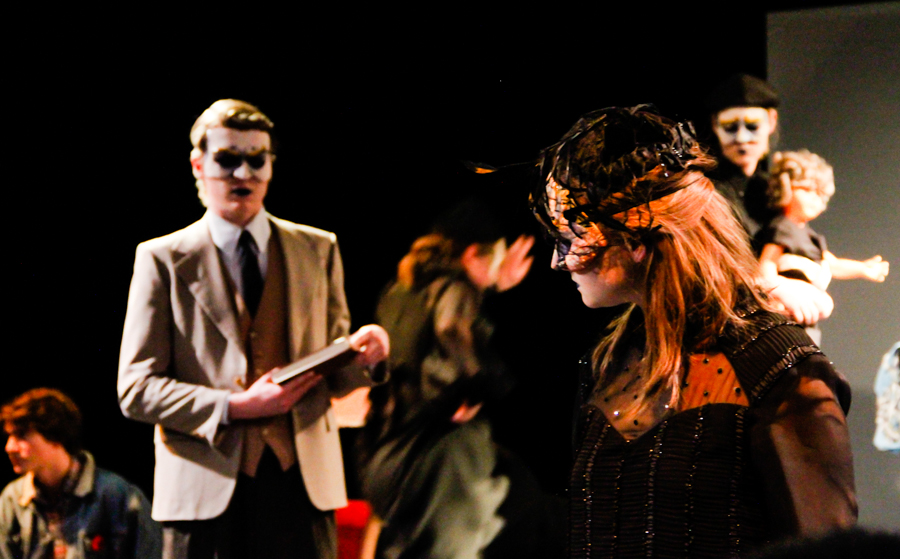If language is constructed based on individual perceptions of our surroundings, then how can subjective reality ever be shared? Anna Gordon wrestles with this tension between ‘fact’ and ‘fiction’ in her interpretation of Luigi Pirandello’s Six Characters in Search of an Author, presented by Players’ Theatre.
Six Characters opens with a director and his actors during a play rehearsal. Before long, a masked family of six interrupts the rehearsal, claiming to be unfinished characters in search of an author. The six characters explain that they came into this near existence from the mind of an author, who then denied them full life when he abandoned them as figments of his imagination. The Director, played by Mal Cleary, allows The Characters to tell their story; The Director’s Actors become a second audience, and a meta play-within-a-play ensues.
The nameless Characters tell their family history to The Actors in the hope that they will perform their story, granting them full existence. They explain that The Mother (Julianna Astorino) and The Father (Nicholas LePage) have an illegitimate child, The Son (Oskar Flemer), while The Mother subsequently had three more children with another man who died. They tell The Actors of their complex familial relations, centring on The Stepdaughter’s (Mars Zaslavsky) work as a sex worker, due to her family’s poverty. The initial explanation, however, is only one version of the family’s story. As the play goes on, The Actors begin to act out The Characters’ story, and contradicting perspectives and narratives are revealed. In an interview with The Daily, director Anna Gordon pointed out that each of The Characters “has a different telling of the story.”
On stage, the six Characters echo Gordon, admitting that the words that create their reality are tricky and interpretive, and their meanings always subjective. Six Characters challenges the audience to grapple with contradictory accounts that are all, to an extent, both true and false. This dilemma is the essence of the play, as The Director and his Actors struggle to see that representing a universally true life experience on stage is impossible.
“we all live in our own internal worlds and our entire perceptual systems are mediated by our own inner experiences. […] Humans are constantly performing.” – Anna Gordon, director of Six Characters in Search of an Author
Busting the myth of objective truth, Pirandello’s play also collapses the barrier between reality and performance, as The Director and his Actors struggle to wrap their heads around their uncanny situation. Since The Characters are fictitious, yet truly alive on stage, they cannot be understood as anything but corporeal. Their reality is bound to The Actors’ subjective interpretation and performance of that reality, and vice versa. Gordon explained to The Daily that “we all live in our own internal worlds and our entire perceptual systems are mediated by our own inner experiences. […] Humans are constantly performing.” By this logic, theatre and real life are inextricably intertwined. Neither is anything but the active shaping of an ongoing story.
Normally, this classic theatrical trope – the ‘play-within-the-play’ – could be considered overdone, if not for the theme of Six Characters. The existential struggles that define this particular play-within-a-play make it necessary for it to be confusing, fragmented, and mind-boggling.
Thankfully, the Players’ cast and director guide the audience, rendering the confusion beautiful. To contrast the many layers of the plot, the stage is, for the most part, bare. The only constant prop is the white shadow screens, with actors posed behind to display creepy tableaus in the background of the set. The screens add a whole other dimension to the play: while the action on stage occurs, the audience also experiences the reactions of the offstage family, as they fear the upcoming, inevitable pain of the family on stage.
Along with the play’s mind-bending nature, Gordon’s blocking of movement also plays an essential role. The constant and dramatic movement on stage – running, pacing, and falling to one’s knees – simplifies the plot, giving the two audiences space to breathe as they try to understand all that happens.
The costumes, too, enhance not only the show’s aesthetics but also its accessibility. The Characters all wear white plaster masks, which separate Actor from Character. The patterned masks make their faces look as if they had been sketched, much like unfinished drawings. Each character has a different set of eyebrows painted on their mask, which reveal their dominant emotion, such as sadness or anger. The Father’s is hardest to pin down, perfectly in line with his wiliness.
Unfortunately, the masks also prevent facial expression, and as such The Characters rely on their voices to deliver emotion. Much of the time, the actors resort to increasing their volume to convey strong feelings. This constant noise quickly loses its effect, leaving the actors with little variety in their vocal tones. Volume is a powerful tool, but in smaller doses. The actors do, however, maintain believability – particularly LePage and Zaslavsky, who strengthen each other’s acting through the clash between their characters. The masked children are also especially engaging; Flemer’s stage presence is full of energy, complementing Natasha Ukolova’s eerie non-speaking part. Cleary, as The Director, takes full advantage of his unmasked face to convey emotion, his eyes acquiring an excited look whenever The Director was particularly inspired by the play.
Six Characters in Search of an Author is a mix of heavy dramatism, absurdism, meta-theatre, and comedy. Players’ Theatre takes a confusing narrative and turns it into a sophisticated spectacle, inviting you to get lost in the layers.
Six Characters in Search of an Author runs November 19 to 22 at Players’ Theatre (SSMU Building, third floor). Tickets are $6 for students.

